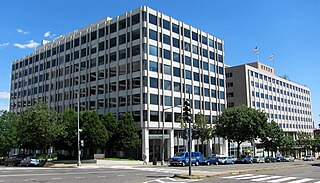
A trust is a legal relationship in which the owner of property, or any transferable right, gives it to another to manage and use solely for the benefit of a designated person. In the English common law, the party who entrusts the property is known as the "settlor", the party to whom it is entrusted is known as the "trustee", the party for whose benefit the property is entrusted is known as the "beneficiary", and the entrusted property is known as the "corpus" or "trust property". A testamentary trust is an irrevocable trust established and funded pursuant to the terms of a deceased person's will. An inter vivos trust is a trust created during the settlor's life.
Corporate personhood or juridical personality is the legal notion that a juridical person such as a corporation, separately from its associated human beings, has at least some of the legal rights and responsibilities enjoyed by natural persons. In most countries, a corporation has the same rights as a natural person to hold property, enter into contracts, and to sue or be sued.

Intestacy is the condition of the estate of a person who dies without a legally valid will, resulting in the distribution of their estate under statutory intestacy laws rather than by their expressed wishes. Alternatively this may also apply where a will or declaration has been made, but only applies to part of the estate; the remaining estate forms the "intestate estate". Intestacy law, also referred to as the law of descent and distribution, which vary by jurisdiction, refers to the body of law, establish a hierarchy for inheritance, typically prioritizing close relatives such as spouses, children, and then extended family members and determines who is entitled to the property from the estate under the rules of inheritance.
In law, a legal person is any person or legal entity that can do the things a human person is usually able to do in law – such as enter into contracts, sue and be sued, own property, and so on. The reason for the term "legal person" is that some legal persons are not people: companies and corporations are persons legally speaking, but they are not people in a literal sense.

A charitable organization or charity is an organization whose primary objectives are philanthropy and social well-being.
Unowned property includes tangible, physical things that are capable of being reduced to being property owned by a person but are not owned by anyone. Bona vacantia is a legal concept associated with the unowned property, which exists in various jurisdictions, with a consequently varying application, but with origins mostly in English law.

A purpose trust is a type of trust which has no beneficiaries, but instead exists for advancing some non-charitable purpose of some kind. In most jurisdictions, such trusts are not enforceable outside of certain limited and anomalous exceptions, but some countries have enacted legislation specifically to promote the use of non-charitable purpose trusts. Trusts for charitable purposes are also technically purpose trusts, but they are usually referred to simply as charitable trusts. People referring to purpose trusts are usually taken to be referring to non-charitable purpose trusts.
Laws regulating nonprofit organizations, nonprofit corporations, non-governmental organizations, and voluntary associations vary in different jurisdictions. They all play a critical role in addressing social, economic, and environmental issues. These organizations operate under specific legal frameworks that are regulated by the respective jurisdictions in which they operate.

Issuer is a legal entity that develops, registers, and sells securities for the purpose of financing its operations.
In relation to juristic persons, the constitutional documents are the documents which define the existence of an entity and regulate the structure and control of that entity and its members. The precise form of the constitutional documents depends upon the type of entity, such as corporations or private associations.

English trust law concerns the protection of assets, usually when they are held by one party for another's benefit. Trusts were a creation of the English law of property and obligations, and share a subsequent history with countries across the Commonwealth and the United States. Trusts developed when claimants in property disputes were dissatisfied with the common law courts and petitioned the King for a just and equitable result. On the King's behalf, the Lord Chancellor developed a parallel justice system in the Court of Chancery, commonly referred as equity. Historically, trusts have mostly been used where people have left money in a will, or created family settlements, charities, or some types of business venture. After the Judicature Act 1873, England's courts of equity and common law were merged, and equitable principles took precedence. Today, trusts play an important role in financial investment, especially in unit trusts and in pension trusts. Although people are generally free to set the terms of trusts in any way they like, there is a growing body of legislation to protect beneficiaries or regulate the trust relationship, including the Trustee Act 1925, Trustee Investments Act 1961, Recognition of Trusts Act 1987, Financial Services and Markets Act 2000, Trustee Act 2000, Pensions Act 1995, Pensions Act 2004 and Charities Act 2011.

Scots property law governs the rules relating to property found in the legal jurisdiction of Scotland.
In English law, a purpose trust is a trust created for the fulfillment of a purpose, not for the benefit of a person. These are normally considered invalid by the courts because they have no legally recognized beneficiaries, therefore nobody to enforce the trust, with the exception of charitable trusts, which are enforceable by the Attorney General as they represent the public interest. As well as charitable trusts, there are several exceptions to the rule against purpose trusts. If the requirement to fulfill a purpose is a request, rather than an obligation, the trust is valid; a trust will also be found valid if, while being for a purpose, it involves beneficiaries in some respect. Purpose trusts can also be valid if they are for the erection or maintenance of tombs and memorials, the maintenance of animals, and arguably the saying of masses, although these must all obey the rule against perpetuities and not continue for more than 21 years after the testator's death.

Resulting trusts in English law are trusts created where property is not properly disposed of. It comes from the Latin resultare, meaning to spring back, and was defined by Megarry VC as "essentially a property concept; any property that a man does not effectually dispose of remains his own". These trusts come in two forms: automatic resulting trusts, and presumed resulting trusts. Automatic resulting trusts arise from a "gap" in the equitable title of property. The equitable maxim "equity abhors a vacuum" is followed: it is against principle for a piece of property to have no owner. As such, the courts assign the property to somebody in a resulting trust to avoid this becoming an issue. They occur in one of four situations: where there is no declaration of trust, where an express trust fails, where there is surplus property, or upon the dissolution of an unincorporated association. Rules differ depending on the situation and the type of original trust under dispute; failed charitable trusts, for example, have the property reapplied in a different way from other forms of trust.

A voluntary group or union is a group of individuals who enter into an agreement, usually as volunteers, to form a body to accomplish a purpose. Common examples include trade associations, trade unions, learned societies, professional associations, and environmental groups.

Westdeutsche Landesbank Girozentrale v Islington LBC[1996] UKHL 12, [1996] AC 669 is a leading English trusts law case concerning the circumstances under which a resulting trust arises. It held that such a trust must be intended, or must be able to be presumed to have been intended. In the view of the majority of the House of Lords, presumed intention to reflect what is conscionable underlies all resulting and constructive trusts.
Re Bucks Constabulary Widows and Orphans Fund Friendly Society [1979] 1 All ER 623 is an English trusts law case, concerning the policy of the "beneficiary principle" and unincorporated associations.
Re West Sussex Constabulary's Widows, Children and Benevolent (1930) Fund Trusts [1971] Ch 1 is an English trusts law case, concerning the policy of the "beneficiary principle" and unincorporated associations.

Hanchett‐Stamford v Attorney‐General[2008] EWHC 330 (Ch) is an English trusts law case, concerning the destination of property that is held by unincorporated associations when they wind up. The High Court applied the view that while the association exists, assets are held jointly by the members but according to the terms of the association contract, and when the association ends any surplus funds go to those who were members of the association at the moment of its dissolution.








